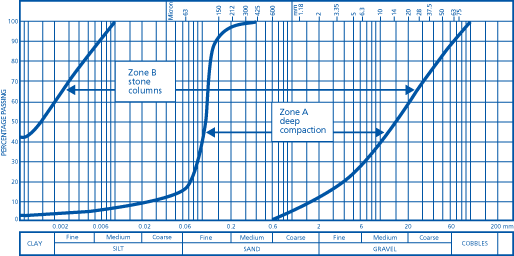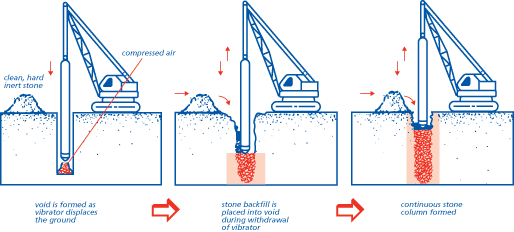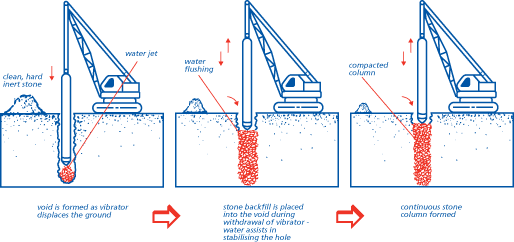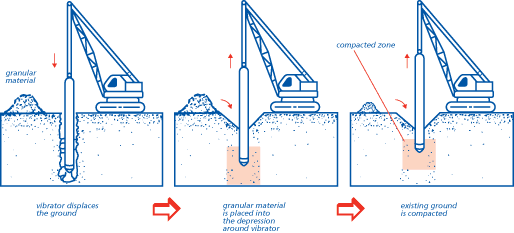4.6 Vibratory ground improvement techniques
| 4.6 - Appendix 4.6A | |
| Soil classification chart | |
| Vibratory techniques | |
| 4.6 - Appendix 4.6B | |
| Materials for use as fill | |
Appendix 4.6-A
SOIL CLASSIFICATION CHART
Conditions acceptable for treatment are only those within zones A and B of the chart.
Vibratory techniques
The vibratory process is applied usually to weak natural soils and filled ground. The purpose is to improve the load bearing capacity, reduce settlement and provide an adequate bearing stratum for the foundation supporting the dwelling.
A decision to buy a hazardous site is an acceptance by the builder/developer of the risks involved. It is important that the ground hazards are assessed before buying the site, and that allowance is made in foundation design for any consequences of this assessment.
Hazardous sites are defined in NHBC Rules.
ACCEPTABLE METHODS
Several vibratory techniques are acceptable. Some use a vibrating poker suspended from a crane. The poker penetrates the ground under its own weight aided by horizontal vibration and thus forms a void. Other techniques use an impact hammer system to form and compact stone columns. The two common techniques are:
Stone columns - Dry process
(applicable to soft clays and silts and to inorganic filled ground)
The poker is withdrawn to leave a void which is partially filled with stone. The poker is then reintroduced and used to compact the stone and the surrounding strata. This process is repeated until the whole void is filled with compacted stone and the surrounding existing granular strata increased in density. Penetration of the poker is assisted by compressed air delivered to the nose of the vibrator which also releases suction on withdrawal.

Stone columns - Wet process
(applicable to soft clays and silts and to inorganic filled ground, and where the water table is high)
The process is similar to the dry process except that water is used to maintain ground stability and to keep the stone 'clean' while it is being placed and compacted.
Note: Special bottom feed pokers or choke tubes which introduce stone into the void via the end of the poker or tube are available. These use compressed air as a flushing medium but can be used in weak ground or ground with a high water table.
A third technique is:
Deep Compaction
(applicable to saturated fine sands, which are rarely found in the UK)
After penetration the poker is withdrawn in stages and compacts the existing strata. Granular material is introduced in a similar manner to the wet and dry process. Water flushing, where excess water drains into sands, can assist this process.
Alternative systems, methods or variations to those given in this Chapter must be shown to be suitable for their purpose and for the conditions for which they are intended, prior to acceptance by NHBC.
On completion of the vibratory ground improvement, the combined ground/column system offers support to the foundations for the proposed structures. The application of vibratory techniques improves the strength of the combined ground/column system and the stiffness by between two and three times in clay soils. Settlements of the treated area may therefore be reduced to between half and a third of the magnitude of that which would otherwise occur.
Note: The stone columns produced by vibratory techniques are not piles and should never be considered so. Stone columns derive their capacity by interacting with the surrounding ground. Piles are more than 10 times stiffer than stone columns.
The compaction is localised and could be variable. Reinforced foundations are needed.
It should not be assumed that all of the surrounding ground has been improved.
Appendix 4.6-B
MATERIALS FOR USE AS FILL
Hazardous materials
The following materials require testing to ensure their suitability for use as fill to support structural foundations and slabs or as backfill to associated trenches:
- acid wastes
- reactive materials
- materials that include sulfates (eg gypsum)
- organic materials
- toxic materials
- materials that cause noxious fumes, rot, undue settlement or damage to surrounding materials.
Test requirements
Tests should be carried out by a suitably qualified person with a detailed knowledge of:
- the material to be tested, and
- the proposed conditions of use.
The samples tested must be representative of the true nature of the material. It may be necessary to take a number of samples to find out the material characteristics of the fill.
Sulfate content should be expressed as a percentage SO4 by weight on the basis of acid soluble testing, taking full account of the recommendations of BRE Digest 363 and BS 5328 Part 1.
Sources of fill material
Where the material is of a stable and uniform type from one source, it may only be necessary to check its suitability once. If material is variable, or from a number of sources, it should all be suitable. Regular inspections and/or testing may be required.
Where industrial waste is permitted as fill material, it is essential that sufficient testing is carried out to ensure suitability.
Where material is obtained from stockpiles, check the material is uniform. Different forms of stockpiling can affect particle size/grading. The outside of a stockpile may be weathered and may not be the same as unweathered material.
Fill requiring NHBC approval
The following types of fill should not be used unless written permission has been obtained from NHBC:
- colliery shale and any other residue from mineral extraction
- slags
- furnace ashes and other products of combustion
- material obtained from demolition
- on wet sites, or sites with a high water table, crushed or broken bricks which have no limit on their soluble salt content (as defined in BS EN 771).
Expansive materials
Fill containing expansive materials is not acceptable for use as support to structural foundations and slabs or as backfill to associated trenches.





















